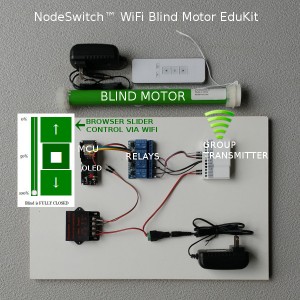This kit includes the TMDG-12-25-16-40-RB motor (mounting brackets and AC charger included); for more info, please see this comparison table of blind motors.
Micropython is a compact but powerful subset of the Python programming language that can be used to program the advanced ESP32 microcontroller from Espressif® - perfect as a sensor node for the Internet of Things (IoT).
We use it as our main wireless sensor node for the Internet of Things (IoT) because it can reboot and connect to your wifi network in less than a second.
The ESP32 is also a champion when it comes to power consumption. It has a deep sleep mode that consumes only 0.01 mA (1 mA = 1 milliAmp = 1 one thousandth of an Amp). That translates to a theoretical minimum current requirement of 10 microamps, giving it the ability to run on simple AA batteries for many years.
Please see Micropython for ESP32 article series
This kit includes the following:
- ESP32 board with OLED display, pre-loaded with Micropython example programs, ready to run (and software for controlling low voltage relays)
- The board also has a charging circuit and connector for a 3.7v lithium battery for battery backup (battery not included)
- 12v DC blind motor (12 lb lift capacity) with built-in digital radio
- 5 ch remote control (sets travel limits and operates blind motor)
- 1 ch blind group controller radio transmitter
- 4 ch low voltage relay module (trigger for group transmitter)
- 12v AC/DC power supply provides 12v to power the system
- 5v power supply splitter module powers ESP32
- Dupont type interconnect wiring harnesses just slide onto pin headers
- Fully illustrated instructions online
The ESP32: Low Power, Deep Sleep, Fast Internet Connection
You can display an example gauge for showing data sent wirelessly from an ESP-32 to a Node-RED dashboard gauge on the Raspberry Pi (not included in this kit).
The ESP32 is a second generation product from Espressif, superseding the now famous ESP8266 microcontroller, the first MCU with WiFi built right into the chip die substrate.
The ESP32 with built-in OLED display can be used as a stand-alone wifi data monitor and control module. The ESP32 improves on the ESP8266 in many areas, such as the ability to reduce power to a very low number in sleep mode.










